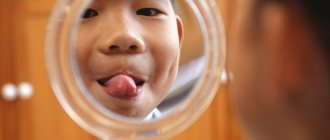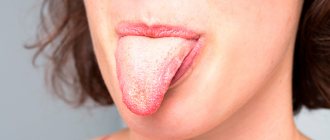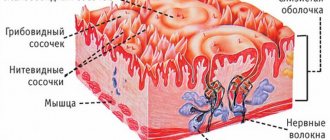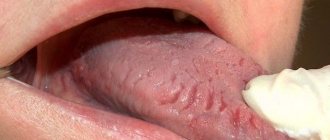Introduction to linguistics
Diagnosis by language is best carried out in daylight or in the light of fluorescent lamps. Better - in the morning, immediately after waking up. Please note that the color of the tongue can be changed by foods, physical activity, stress, and nasopharyngeal diseases.
So, go to the mirror and stick your tongue out at him. Now carefully examine its appearance. Normally, this organ should be pale pink, with a smooth, velvety surface. At the tip of the tongue there are small papillae, in the middle part there are larger ones, and at the root there are whole clusters. There are approximately ten thousand of them in total. These are taste, heat and biochemical analyzers associated with various parts of the body.
The tip of the tongue is believed to reflect the condition of the heart and lungs. In the middle, on the very “body” of the organ, there is a projection of the stomach and spleen. The branches of the liver and gall bladder run along the lateral edges. By changes in the language, you can discern ailments that have already appeared, as well as guess about future problems. As a rule, warning signs in the tongue appear several days before other symptoms accompanying a particular illness.
Correspondence of tongue zones to internal organs
To determine the state of health by the tongue, it should be taken into account that the tongue is conventionally divided into separate zones responsible for certain internal organs. When identifying pathologies, the doctor will first of all pay attention to the dislocation of changes in the tongue. An interesting fact is that from the point of view of ancient eastern practices, language is also divided into areas according to five “primary elements”:
READ ALSO: burning in the mouth, burning tongue and lips: causes and treatment
- back - Water,
- central region - Earth,
- sides – Wood,
- between the tip and the central part - Metal,
- tip – Fire.
| Tongue area | Relevant authorities |
| Tip | Heart, small intestine |
| Sides | Liver, gall bladder |
| The area between the tip and the central zone (the transversely band-like part encircling the organ) | Respiratory system, immune system, large intestine |
| Central zone | Stomach, pancreas, spleen |
| Rear end | Genitourinary system |
| Longitudinal fold in the middle of the organ | Spinal column |
Color change
The shape, size, outline, color and surface of the tongue are important for diagnosis. Let's start with color.
● Pallor may indicate anemia and poor circulation, as well as intestinal dysfunction.
● A yellowish tint will indicate excess bile in the gallbladder or liver dysfunction.
● Blueness of the middle and especially the lower part of the tongue is associated with cardiac pathology.
● Raspberry color is a consequence of damage to the blood system.
Changes in the color of individual areas of the tongue indicate problems in the organ for which this area is “responsible”. For example, redness of the tip occurs with ailments of the pelvic organs, and if the tongue changes color in the middle part along the edges, the reason probably lies in pulmonary diseases.
● Plaque indicates the presence of toxins in a particular part of the digestive system. The coated back of the tongue indicates slagging in the large intestine, and if the middle of the tongue is “powdered,” it means problems in the stomach or small intestine. A yellowish, gray or brownish coating can identify ailments of the gastrointestinal tract; blue - typhus, dysentery.
Is my tongue my doctor? What diseases can be identified by the organ of taste?
The tongue is one of the most important organs in the body. It contains receptors that allow you to recognize all shades of taste of products entering the oral cavity.
As scientists noted back in ancient times, human language has a connection with various organs of the body. When diagnosing, they divided it into conventional parts: basal, middle and tip. And they believed that in case of pathology of a particular organ, the lesion would be observed strictly in one of these areas. AiF.ru looked into what diseases leave their mark on the language together with Professor, Doctor of Medical Sciences, head of the laboratory for the development of an interdisciplinary approach to the prevention of chronic non-infectious diseases of the Federal State Budgetary Institution "State Research Center for Preventive Medicine of the Ministry of Health of Russia", expert of the National Health League Mehman Mamedov .
Color spectrum
When examined by a doctor, you are often asked to show your tongue. And they do this not out of idle curiosity. After all, even by the color of the tongue it is quite possible to determine whether there is a particular disease. For example, the tongue of a healthy person should be pale pink: this is what is accepted as the norm. If there is a white coating on the tongue, we can talk about fungal infections of the body or disorders of the gastrointestinal tract. A gray tongue is usually the result of chronic pathologies. Bright red - will indicate infectious and inflammatory processes in the human body; if the red color has a shade of scarlet, doctors will suspect problems with the circulatory system. A burgundy tint is a clear sign of an acute infectious process. The tongue is part of the gastrointestinal tract, and is also connected with the respiratory system, because located in the oral cavity. With stomach and duodenal ulcers, problems with the gallbladder, liver and intestines, there may be changes in the color of the tongue. Each disease has its own manifestations - in some places it can be more contrasting, in others it can be lighter.
It also happens that the color of the tongue changes to blue and purple. In this case, they talk about problems with the lungs or severe kidney ailments. Yellowing of the tongue is not only a characteristic feature of a heavy smoker, but also a signal of problems with the gastrointestinal tract. If there is a lack of vitamins in the human body, the tongue may completely lose color.
It is worth considering that a shade that is too dark and saturated is a sign of problems that require immediate medical intervention, or even hospitalization.
Additional factors
However, not only color matters. If the tongue is too dry, the following diagnoses may be made: dehydration, intestinal obstruction, peritonitis. Often, dry tongue is observed with an increase in body temperature. If the situation approaches critical, the taste organ may even crack due to dryness. In this case, an additional threat is created: it is easily infected with bacteria, resulting in suppuration and severe inflammation.
The type of coating on the tongue is also of particular importance. So, if it is thin, it means that the disease is in the initial phase, and if it is frankly fatty and thick, then the problem most likely lies in pathologies of the gastrointestinal system: this usually happens if mucus has accumulated there and food stagnates. A spotted and purple coating indicates the development of blood stagnation. Malfunctions in the digestive system will cause the tongue to become slightly swollen and wet. In this case, it is recommended to be checked for gastritis, cholecystitis, ulcers and even appendicitis.
Doctors pay special attention to the place where plaque accumulates. So, if it is more adjacent to the root of the tongue, then problems are noted in the large intestine: most likely, many human waste products have accumulated there and cannot find a way out. Plaque in the middle indicates problems in the small or duodenal intestine or stomach. If the plaque is so thick and the tongue is so swollen that you can see teeth marks along the edge, you need to reconsider your diet: with a high degree of probability it can be said that the intestines cannot cope with the food that a person eats.
The presence of deep wrinkles and cracks located transversely should alert you and send you to a neurologist - as a rule, this problem manifests itself with a predisposition to vascular disorders of the brain.
The tongue can even indicate serious cardiac and vascular problems, which may occur without any symptoms for some time. For example, a tongue that is slightly shifted to the side or slightly bent will indicate a hemorrhagic stroke, cerebrovascular accidents, or problems with the functioning of the cerebellum.
An increase in the volume of the taste organ may be a consequence of problems with the thyroid gland, malfunction of the pituitary gland, or mental disorders.
Shaky and grainy
Sometimes a person may notice that his tongue... trembles. This condition indicates nervousness and problems with the central nervous system. In such a situation, doctors recommend changing the psychological environment, as well as working on your lifestyle. It is also worth checking with a doctor if your sense of taste begins to decrease. After all, it does not develop out of the blue: there must be a reason why a person no longer feels the tastes to which he is accustomed. Moreover, it is important to understand that there are certain zones and areas on the tongue that are responsible for the reaction to different tastes: spicy, salty, sweet, etc. If a malfunction is noted in any of the parts, this may indicate that the nervous system is suffering. or endocrine system. Loss of taste in the taste buds of the tongue manifests itself as a result of metabolic disorders in the human body, as well as malfunctions of the central system of various etiologies, the development of anemia and the presence of cancer.
Also, people often begin to notice that the tongue has become rougher: this is due to an increase in the size of the papillae on the surface of the organ. When swollen papillae are localized at the tip, it is worth being examined by a cardiologist. If the tongue becomes “spiky” around the edges, you need to check the liver. An affected middle part of the tongue indicates problems in the stomach and intestines. At the same time, you should not rejoice when the tongue becomes smooth and “mirror-like”. After all, this is also a pathology. This happens with anemia, exhaustion or severe pathologies of the stomach.
Identification marks
Ulcers, spots, lines on the tongue can also tell a lot to an experienced interpreter. Thus, a curved line running in the middle of the tongue “hints” at a deformation or curvature of the spine.
Enlargement or inflammation of the papillae on the entire surface of the tongue often occurs with gastritis with increased secretion of gastric juice. And, conversely, a smoothed surface of the tongue occurs with gastritis with low acidity, as well as with diseases of the liver and gall bladder. The imprint of teeth along the edges of the tongue indicates poor intestinal function and insufficient digestion of food. The so-called “geographical” language, in which continents and oceans seem to be imprinted, is a sign of food allergies. One crack in the tongue appears with gastritis, and numerous creases appear with fever, diarrhea, diabetes, and anemia.
Newspaper "News of Medicine and Pharmacy" 10 (416) 2012
All internal changes of the human body: states of deficiency or excess of internal organs, any state of recent or developed illness, state of fullness or deficiency of body fluids, states of strength or decline of Qi and Blood - can be objectively reflected by characteristic changes in the tongue. Dr. Ze-Lin Chen, China
The article presents literature data and our own clinical observations of the condition of the oral mucosa in children with various pathologies. Assessing the condition of the tongue is important when describing the objective status of the patient, especially in the dynamics of observation. Its reflection in medical documentation is a simple and important screening indicator for drawing up a diagnostic search algorithm, as well as an additional criterion for the effectiveness of treatment, rehabilitation and prevention of various diseases.
Since ancient times, doctors have tried to assess the patient’s health status by its external signs, since they already knew about the unity of the body and the interconnection of all organs and systems, as well as the fact that dysfunction of one of them leads to changes in the other.
Despite the fact that currently there is a huge arsenal of various laboratory and instrumental diagnostic methods based on modern technologies, the doctor’s assessment of the patient’s objective status remains important. It is not for nothing that popular wisdom says that in front of any modern device “you must take off your hat and leave your head on your shoulders.”
According to the postulates of Ayurveda (ancient Indian health science) and Chinese medicine, changes in the pulse in the radial artery and the condition of the skin and mucous membranes, including the tongue, carry information about the presence of a number of diseases [1, 2]. Even Hippocrates, in his descriptions of diseases, attached great importance to changes in the mucous membrane of the tongue. So, with pleuropneumonia, he indicated a greenish color in its upper part, with jaundice - a yellow color and thick black sublingual veins [3]. Currently, assessment of the condition of the tongue remains important when examining a patient in Tibet, India and China.
The tongue is a muscular organ involved in the mechanical processing of food, the act of swallowing, the perception of taste, and the formation of speech. The mucous membrane of the tongue is quite resistant to the action of various mechanical, chemical and thermal factors during food and water intake. It is characterized by high regenerative ability (renewal every three days), as well as relative resistance to infection. In the superficial layer of the mucous membrane there are papillae, which are organs of taste and tactile sensitivity. Papillae are divided according to shape, size and function into four types: filiform, grooved, fungiform and foliate. Filiform papillae are the most numerous (up to 500 per 1 cm2), covered with keratinizing epithelium, play the role of organs of touch and perform a mechanical function. Fungiform papillae, ranging from 40–50 to 90 per 1 cm2, are located among the filiform papillae; there are more of them on the tip of the tongue and in the middle part of the back. The epithelium covering these papillae does not keratinize. The fungiform papillae contain thermoreceptors and so-called taste buds, in which 50–100 taste receptor cells are concentrated. Newborns usually have more taste buds than adults, some of whom degenerate and disappear with age. Grooved papillae, numbering from 7 to 12, are also taste organs, located on the border between the root and body of the tongue, and do not protrude above the surface of the mucous membrane. The ridge of mucous membrane surrounding each papilla is separated from it by a deep groove into which the excretory ducts of the small serous salivary glands of Ebner open. Leaf-shaped papillae, numbering 15–20, consist of vertical folds that are located at the base of the lateral surface of the tongue. Their epithelium also contains taste buds. Different parts of the surface of the tongue have unequal sensitivity to taste stimuli. Thus, the root of the tongue is more sensitive to bitter taste, the side surfaces are more sensitive to sour taste, the side surfaces and tip are more sensitive to salty taste, and the tip of the tongue is more sensitive to sweet taste [4, 5].
According to the canons of Chinese medicine, all human internal organs have a projection zone onto certain areas of the tongue (Fig. 1). Thus, the tip carries information about the state of the heart; the area in front of the tip of the tongue reflects the condition of the lungs; the central part of the tongue - the stomach, pancreas; middle third, lateral to the median sulcus - spleen, liver and gall bladder; back part - kidneys; the root of the tongue is the intestine [4, 5]. Therefore, by the appearance of the tongue one can judge the condition of the patient’s internal organs. To do this, it is necessary to determine the size, surface structure, color and moisture content of the tongue [2].
In a healthy person, the mucous membrane of the tongue is pale pink, without plaque, with an even fold in the middle, and well-defined papillae. In the hot season, the papillae of the tongue have a reddish tint and are slightly enlarged. In healthy young children, the mucous membrane of the tongue is pink, and V-shaped ridge-shaped papillae are prominent. Leaf-shaped papillae on the lateral surfaces of the tongue appear only by 6–7 years [6].
The condition of the mucous membrane of the tongue is influenced by the composition of food, injuries (mechanical, thermal, chemical), toxic-allergic effects (dental materials, medicinal substances, etc.) [6, 7]. Thus, spicy foods and spices (marinades, cayenne pepper, curry, etc.) have an irritating effect and give the tongue a red color for a short time; drinking strong coffee turns it brown, and drinking beets turns it purple. Smoking can cause yellow plaque, while taking antibiotics can lead to partial disappearance of areas of epithelium on the surface of the tongue.
With infectious and inflammatory diseases, the tongue becomes hyperemic, with chronic diseases and anemia - pale, with biliary dyskinesia, cholecystitis, viral hepatitis - yellow. In diseases of the lungs and cardiovascular system, the tongue becomes cyanotic.
When analyzing the condition of the tongue, it is important to note the quality and quantity of plaque present. A healthy person, for example, has a thin white coating that can be easily removed with a toothbrush or tongue brush. A white, dense coating, depending on the area of location on the tongue, is a sign of an inflammatory process in any organ, and can also be a manifestation of endogenous intoxication (constipation, the presence of toxic and conditionally toxic macro- and microelements in the body, renal and liver failure, etc. .) (Fig. 2). A brown coating can appear in patients with diseases of the lungs and intestines, a yellow coating can appear in patients with congestion in the gallbladder.
Vertical grooves along the edges of the tongue are observed in various diseases of the gastrointestinal tract (Fig. 3).
An uneven longitudinal groove in the middle of the tongue can be observed in patients with poor posture. Moreover, its location in the anterior third of the tongue indicates curvature of the cervical, middle third - thoracic, and posterior third - lumbar spine (Fig. 4).
Thickening of the tongue occurs with various liver pathologies. Teeth imprints on the lateral surfaces of the tongue appear in patients with chronic enterocolitis and dyspepsia. Dry tongue, numerous cracks are observed with fever, diarrhea, diabetes, anemia. Tremor of the tongue can be a manifestation of neurasthenic syndrome, vegetative neurosis, thyrotoxicosis [2, 5–8].
Particular attention should be paid to the presence of the so-called geographic tongue, which is clinically manifested by areas of hyperemia, alternating with gray areas up to 0.5 cm in diameter, which are delimited from each other by yellowish-gray ridges consisting of thickened filiform papillae (Fig. 5). Over the course of several days, these areas may change their shape and location. Merging with each other, they create a pattern on the tongue that resembles a geographical map. This condition was first described by the French physician Rayer in 1831. Such desquamation of the epithelium of the mucous membrane of the tongue is typical for patients with atopic dermatitis, helminthic infestation, gastroesophageal reflux disease, biliary dyskinesia, gastritis with reduced secretory function, viral hepatitis [2, 6, 8] .
Most often, changes in the oral cavity are accompanied by diseases of the gastrointestinal tract. This is explained by the common morphological structure of the oral mucosa and the digestive tract [9]. So, according to E.G. Romanenko, who examined 162 children with chronic gastroduodenitis, 76.3% of them had hyperkeratosis of the filiform papillae, 69% had hyperemia and swelling of the tongue, and 64% of the subjects had hypertrophy of the fungiform and foliate papillae. In children with increased acid-forming function of the stomach, increased salivation was observed, which is due to the parallelism in the work of the salivary glands and the glands of the fundus that produce mucus [10]. Often, patients with hypersalivation had swelling of the tongue with tooth marks on the lateral surfaces (Fig. 6).
For gastroesophageal reflux disease, multiple demineralization of hard dental tissues, the presence of a geographic tongue and/or white plaque that does not have a clear localization are pathognomonic. In chronic gastroduodenitis without impaired motor function, plaque is distributed evenly [10]. In case of peptic ulcer of the stomach and duodenum, the tongue is swollen, covered with a coating that is difficult to remove, and sometimes with sticky mucus [8]. In chronic liver diseases, hemorrhages often appear on the tongue [8, 9, 11]. Acute pancreatitis is characterized by dry tongue, an increase in the number of filiform papillae and hyperplasia of the fungiform papillae; in chronic pancreatitis, atrophic processes can be observed [8]. With intestinal diseases, multiple, sharply painful erosions (aphthae), and a gray-yellow or brown coating may appear in the oral cavity [7, 8, 11].
Changes in the oral mucosa also occur with endocrine diseases. Thus, with hypofunction of the thyroid gland, dryness of the tongue and lips is observed, with its hyperfunction - tremor and decreased taste [1, 11]. Thickening of the tongue and the formation of folds on it (due to an increase in the number of filiform papillae) in combination with other symptoms may be important in the early diagnosis of pituitary dysfunction [1]. With chronic insufficiency of the adrenal cortex, brown spots of various shapes appear on the mucous membrane of the oral cavity and the lateral surfaces of the tongue without signs of inflammation. With hyperfunction of the adrenal cortex, aphthae, areas of hyperkeratosis, and candidomycosis may be detected in the oral cavity due to the catabolic effects of hormones. Diabetes mellitus is characterized by thinning of the mucous membrane, dry tongue, paresthesia, and angular cheilitis [2].
Changes in the oral cavity can become one of the early clinical symptoms of diseases of the blood and hematopoietic organs. Thus, with anemia, there is pallor of the mucous membrane, its dryness, angular stomatitis, atrophy of the epithelium and papillae of the tongue, which becomes sharp and decreases in thickness [1, 7]. A feature of hyperchromic anemia is excessive moisture in the mucous membrane of the tongue, the appearance of hyperpigmented spots on the palate and inner surface of the cheeks [2]. In hemophilia, bleeding is observed from externally intact gums and when biting the tongue [1, 2]. In leukemia, ulcerative-necrotic changes in the oral mucosa can be detected [2].
Lesions of the oral mucosa can occur due to infectious diseases. In particular, with scarlet fever, a crimson tongue is characteristic (Fig. 7).
In patients with heart failure, trophic changes in the tongue may appear in the form of infiltration, pain and necrosis. With decompensated congenital heart defects, the mucous membrane of the tongue becomes swollen, dry, pale with a cyanotic tint [2, 11].
Kidney pathology is characterized by xerostomia (dry mouth), catarrhal gingivitis, erosive stomatitis due to bacterial decomposition of urea by saliva, the so-called ammonia burn [2, 11].
One of the manifestations of hypovitaminosis A is dryness of the oral mucosa, keratinization of the epithelium, with vitamin B1 deficiency - hyperplasia of the fungiform papillae, B6 - angular stomatitis, cheilitis, with vitamin B12 deficiency - desquamative glossitis [2].
To illustrate the above, we present the following clinical case. Child B., 7 years old, complained of frequent coughing during the day with difficult to separate sputum. From the medical history, it is known that the boy was bothered by a cough for 4 months, periodically with symptoms of shortness of breath, participation of auxiliary muscles in the act of breathing, and attacks of wheezing with remote wheezing. Based on the results of a comprehensive clinical, laboratory and instrumental examination, a diagnosis was established: bronchial asthma, atopic form, moderate course, attack period. Within 1 month. received pulmicort as a basic therapy with little effect and persistence of the above complaints. When assessing the objective status, attention was drawn to the pronounced phenotypic manifestations of connective tissue dysplasia: joint hypermobility, weak muscle tone, scoliosis of the thoracic spine, flattened arches of the feet. The skin is of normal color and clean. The mucous membrane of the oral cavity is dry, the tongue at the root is covered with a uniform dense yellow coating, in the area of the tip of the tongue on the right there is a focus of desquamation of the epithelium, curvature of the midline in the anterior third, demineralized tooth enamel (Fig. 8). On percussion there is a clear pulmonary sound over the lungs, on auscultation there is hard breathing in the lungs, there is no wheezing. Other organs and systems without pathology. Additional medical history revealed a positive “wet pillow” symptom, the presence of frequent belching of air, which was the basis for excluding gastroesophageal reflux disease and parasitic infestation.
The results of fibrogastroduodenoscopy revealed moderate hyperemia of the esophageal mucosa in the lower third, prolapse of the folds of the stomach up to 2.5 cm in length of the esophagus, the gastric mucosa is matte, hyperemic, with a large amount of mucus and an admixture of bile. Giardia cysts were found in feces.
Taking into account the results of additional research methods, motilium was added to the basic therapy with pulmicort for 14 days, and a three-stage treatment of giardiasis was prescribed. Against the background of this complex treatment, there was a positive dynamics of broncho-obstructive syndrome (decrease and then disappearance of cough), the condition of the mucous membrane of the tongue (absence of a focus of epithelial desquamation, increased humidity of the mucous membrane, a decrease in plaque and a change in its color) (Fig. 9).
Thus, pathological changes in the functions and structure of various organs and systems are manifested by changes in the mucous membrane of the tongue, starting from the early clinical stages. Assessing the condition of the tongue is important when describing the objective status of the patient, especially in the dynamics of observation. Its reflection in medical documentation is a simple and important screening indicator for drawing up a diagnostic search algorithm, as well as an additional criterion for the effectiveness of treatment, rehabilitation and prevention of various diseases.
Purely concrete
The mandatory daily ritual of brushing your teeth should also include a tongue cleansing procedure. The heterogeneous microrelief of this organ, consisting of papillae of different sizes, is an ideal field for the proliferation of pathogenic bacteria.
The most plaque accumulates in the morning. Therefore, it is better to carry out this procedure at this time of day. Today there are special tongue brushes made of metal, rubber or plastic on sale. But you can get by with improvised means. A regular teaspoon will do. After dipping it in warm water, you need to gently scrape it across your tongue until there are no traces of plaque left on the spoon. After cleaning, the tongue should be lubricated with olive or any other vegetable oil to prevent irritation. A cleaned tongue looks refreshed and healthier. In addition, after this procedure, the taste of food is revealed in a new way, and all the nuances of the taste of well-known dishes are felt much brighter. The use of a brush is especially necessary:
● in the presence of a large amount of plaque; ● with deep cracks in the tongue; ● when there is bad breath; ● smokers.
Another way to cleanse the tongue is the famous lion pose. With your eyes widened and your mouth wide open, you need to stick your tongue out as far as possible, trying to reach your chin. During the exercise, you need to strongly strain the muscles of the face, neck and chin for 5 seconds. Then you can relax for 15 seconds and then repeat the same pose again. 5-6 repetitions are enough. This exercise relieves inflammation of the tonsils, improves thyroid function and eliminates bad breath.
By the way
It's sweeter to be a girl! Our perception of the taste of food depends not only on the state of the tongue, but also on many other factors, including the gender and age of the person. This is exactly the conclusion that Danish scientists came to. Experts conducted a large study involving almost 9,000 schoolchildren. All children received a set of samples of different foods, with the help of which experts had to find out how well boys and girls distinguished tastes of different intensities. It turned out that girls are better at distinguishing one or another taste than boys. Thus, the sensitivity threshold of boys to sour is 10%, and to sweet – 20% lower than that of girls. An important factor in the perception of taste is also the age of a person. Children's taste buds work better than adults'.
Signs of diseases according to the characteristics of the tongue
If a person is healthy, all his organs and systems are functioning normally, then the tongue will be pale pink in color with a smooth surface, covered with a thin film of transparent salivary secretion, with clearly visible papillae, a smooth and straight central fold (we recommend reading: bright pink tongue in a person : causes and treatment). Any changes in color, the appearance of plaque or any marks indicate problems and malfunctions in the body.
It should be borne in mind that the condition of the tongue can be influenced by the foods a person eats. Before performing a tongue diagnosis, it is recommended that you refrain from eating and drinking at least 2 hours before the examination. You can clearly see examples and comments in the photo accompanying the article.
Plaque color
Very often, the development of pathology is indicated by a plaque that appears on the tongue. In order to determine which organ has failed and at what stage of development the disease is, you should pay attention to the color of the plaque. It can be of almost any shade - from white or bright red to yellow, blue and even purple: (we recommend reading: white-yellow coating on the tongue: causes and methods of treatment)
Interesting
Pigs are more sensitive than people. The person is a fairly average taster. He only has 3 thousand taste analyzers. The whale, which swallows a lot of fish without even chewing, has only a few or none at all. The pig, oddly enough, is more taste-sensitive than humans: it has 5,500 taste analyzers. A cow has 35,000 of them, and an antelope has more than 50,000! So not only do animals have a sense of taste, but many of them are much better tasters than humans. Marine animals are often covered in taste buds on the outside. Fish, for example, sense taste over the entire surface of their body. But creatures such as flies and butterflies can taste with their paws. Snakes and lizards use language for this purpose, but not quite in the same way as we do. They seem to shoot out the tip of their tongue, which catches small particles of food. These particles are delivered using the tongue to a special organ in the upper part of the mouth, which tastes and smells food.
Incredible!
Language helps you see. A revolutionary technology that makes it possible to partially restore vision to blind people using the nerve endings of the tongue was created by American scientists. The theoretical basis for the latest technology was laid back in the 1960s by the famous neurosurgeon Paul Bach y Rita. He suggested that a person sees not with his eyes, but with his brain. In this case, vision serves only as a “delivery” of external light signals. Now these scientific assumptions have been confirmed in practice, when scientists have created a special device that largely restores vision. It consists of glasses that capture light and transmit information to a special miniature device. The latter converts light waves into electrical signals that are sent through a thin cable to the tongue. The tongue was chosen as a channel for transmitting signals to the brain, since its nerve endings are very sensitive and capable of transmitting a large amount of information. Thus, the tongue partially replaces the 2 million optic nerves that lead from the human eyeball to the brain. As it turns out, the impulses received by the tongue are converted into images in the brain. The magazine reports that during the tests, blind people using the latest device were able to see the door, floor call buttons in the elevator, and even letters.











